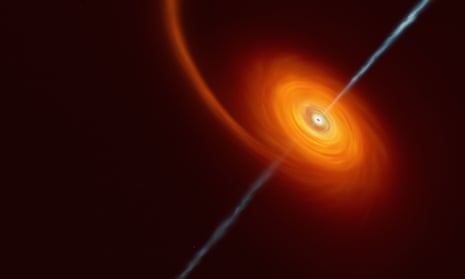Nothing sucks more than a supermassive black hole, but according to a group of researchers, the enormous objects found at the heart of many galaxies may be driving the expansion of the cosmos.
The radical claim comes from an international team who compared growth rates of black holes in different galaxies. They conclude that the spread of masses observed could be explained by black holes bearing cores of “dark energy”, the mysterious force behind the accelerating expansion of the universe.
Instead of dark energy being smeared out across spacetime, as many physicists have assumed, the scientists suggest that it is created and remains inside black holes, which form in the crushing forces of collapsing stars.
“We propose that black holes are the source for dark energy,” said Duncan Farrah, an astronomer at the University of Hawaii. “This dark energy is produced when normal matter is compressed during the death and collapse of large stars.”
The claim was met with raised eyebrows from some independent experts, with one noting that while the idea deserved scrutiny, it was far too early to link black holes and dark energy. “There’s a number of counter-arguments and facts that need to be understood if this claim is going to live more than a few months,” said Vitor Cardoso, a professor of physics at the Niels Bohr Institute in Copenhagen.
Scientists first proposed dark energy in the late 1990s when measurements of distant stars revealed that the expansion of the universe was accelerating. The discovery posed a problem for astronomers, however: given that gravity should be slowing the expansion, what could be driving it faster?
As a placeholder for a solution, researchers came up with dark energy, an unknown force that works against gravity. In its simplest form, dark energy matches the “cosmological constant” that Einstein came up with in 1917. He introduced it as a fix in general relativity to keep the universe from collapsing, but later ditched it, calling it his “greatest blunder”.
In the latest work, researchers compared black hole masses in young galaxies, where stars are still forming, with black hole masses in giant but dormant galaxies, where no more stars are born. In younger galaxies, black holes can grow by swallowing nearby stars and other material, but in the older galaxies, there is little left for them to suck in.
The scientists found that the black holes in dormant galaxies were seven to 20 times more massive than expected, a finding they say points to another process by which the black holes are growing.
In two papers published in The Astrophysical Journal and The Astrophysical Journal Letters, the researchers say the findings could be explained if black holes grow as the universe expands. This could be the case with black holes that are theorised to contain dark energy in their cores, the authors argue.
“The importance of this work is that it’s taken the theories about black holes with dark energy cores and linked them for the first time to tangible observations of the universe,” said Chris Pearson, a co-author on the study and Astronomy Group Leader at STFC RAL Space in Oxfordshire. “These black holes are expected to grow in mass as the universe expands.”
If the scientists are correct, they will have solved the puzzle of the origins, if not the nature, of one of the most mysterious forces in the universe. But far more work is needed before it will gain acceptance. Among many questions remaining is how black holes can pull everything nearby towards them while simultaneously driving the universe apart.
after newsletter promotion
“There are most likely more mundane explanations,” Cardoso said of the results. “The relation this work investigates between black hole mass and universe expansion rate is somewhat naive…and not supported on fundamental principles.”
“What this study could also say is something as simple as ‘black holes evolve differently today than they did billions of years ago’,” he added. “It’s much, much too early to think that black holes are in any way related to dark energy.”
Farrah agrees there is more to do. “We certainly haven’t proved anything here,” he said. “The evidence makes this idea worthy of scrutiny and further test, but it will take a lot more work to confirm or refute it.”
Ofer Lahav, professor of astronomy at University College London, who is involved in galaxy surveys of dark energy, said: “Given the mysterious nature of dark energy, which has been considered in different incarnations for over a century, it is healthy to consider fresh ideas like this, and to think how they can be falsified.”
